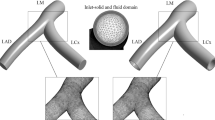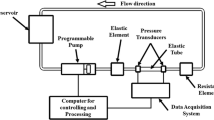Abstract
Diseases of blood vessels are mostly associated with stenoses and aneurysm. Secondary stenoses is an associated condition in both cases. Numerical analysis of hemodynamic in diseased blood vessel was done to evaluate probability of development of secondary stenoses. Relevant viscosity models were considered at disease conditions. Patient-specific profile was considered to represent velocity at inlet of geometry. This velocity profile was transformed to Womersley form prior to application. SIMPLE method was used for correction of pressure, whereas blood rheology was considered as non-Newtonian. Elasticity of vessel was neglected as vessels become more rigid in diseased artery. Continuity and momentum equations were solved for pressure and velocity interpolation throughout entire flow field. Flow in downstream; near boundary walls induced secondary vortices in stenosed vessels, whereas its criticality increased in aneurismal vessel. Oscillatory Shear Index (OSI) and Relative Residence Time (RRT) were formulated along endothelial lining to identify dead regions. Spatial distribution of RRT along vessel wall varied with variations in viscosity model of active fluid (such as Power Law or Quemada model). Simultaneously, OSI and RRT got modulated with change in flow rate. Centerline velocity gets modulated at far downstream from diseased section in comparison to near downstream. Numerical study based on stress parameters shows that vessels with acute aneurysm were more prone to secondary stenoses than vessels with stenoses. Thus, based on numerical results, order of priority for treatment of aneurismal vessels with acute conditions should be made for those showing dual symptoms of diseases in blood vessels.







Similar content being viewed by others
References
Jung, J., Gidaspow, D., & Gamwo, I. K. (2005). Measurement of two kinds of granular temperatures, stresses and dispersion in bubbling beds. Industrial & Engineering Chemistry Research, 44, 1329–1341.
Hyattsville, M. D. (2001). Annual summary with detailed diagnosis and procedure data. National center for health statistics National Hospital discharge survey.
Wassef, M., Baxter, B. T., & Chisholm, R. L. (2001). Pathogenesis of abdominal aortic aneurysms: A multidisciplinary research program supported by the national heart, lung, and blood institute. Journal of Vascular Surgery, 34, 730–738.
Ma, B., Harbaugh, R. E., & Raghavan, M. L. (2004). Three-dimensional geometrical characterization of cerebral aneurysms. Annals of Biomedical Engineering, 32, 264–273.
Siddiqui, S. U., Verma, M. K., Mishra, S., & Gupta, S. (2009). Mathematical modeling of pulsatile flow of Casson’s fluid in arterial stenosis. Journal of Applied Mathematics and Computing, 210, 1–10.
Neofytou, P., & Drikakis, D. (2003). Effects of blood models on flow through a stenosis. International Journal for Numerical Methods in Fluids, 43, 597–635.
Li, Z., & Kleinstreuer, C. (2005). Fluid-structure interaction effects on sac-blood pressure and wall stress in a stented aneurysms. Journal of Biomechanical Engineering, 127, 662–671.
Lin, Y. C., Khanafer, K. M., Bartlett, R. H., Hirschl, R. B., & Bull, J. L. (2011). An investigation of pulsatile flow past two cylinders as a model of blood flow in an artificial lung. International Journal of Heat and Mass Transfer, 54, 3191–3200.
Buchanan, J. R., Kleinstreuer, C., & Comer, J. K. (2000). Rheological effects on pulsatile hemodynamics in a stenosed tube. Computers and Fluids, 29, 695–724.
Bit, A., & Chattopadhyay, H. (2014). Assessment of rheological models for prediction of transport phenomena in stenosed artery. Progress in Comp. Fluid Dynamics-An Int. J., 14(6), 363–374.
Huang, C., Chai, Z., & Shi, B. (2013). Non-Newtonian effect of hemodynamic characteristics of blood flow in stented cerebral aneurysm. Computer Communications Physics, 13, 916–928.
Walburn, F. J., & Schneck, D. J. (1976). A constitutive equation for whole human blood. Biorheology, 13, 201–219.
Chien, S., Usami, S., Dellenback, R., & Gregersen, M. (1967). Blood viscosity: influence of erythrocyte deformation. Science, 157, 827–829.
Quemada, D. (1977). Rheology of concentrated disperse systems III. General features of the proposed non-Newtonian model. Comparison with experimental data. Rheological Acta, 17, 643–653.
Patankar, S. V. (1980). Numerical heat transfer and fluid flow (2nd ed.). New York: McGraw-Hill.
Rhie, C. M., & Chow, W. L. (1983). Numerical study of the turbulent flow past an airfoil with trailing edge separation. AIAA Journal, 21, 1525–1532.
Chattopadhyay, H., Durst, F., & Ray, S. (2006). Analysis of heat transfer in simultaneously developing pulsating laminar flow in a pipe with constant wall temperature. International Communications in Heat and Mass Transfer, 33, 475–481.
Stroud, J. S., Berger, S. A., & Saloner, D. (2002). Numerical analysis of flow through a severely stenotic carotid artery bifurcation. Journal of Biomechanical Engineering, 124, 9–20.
Richardson, L. F., & Gaunt, J. A. (1927). The deferred approach to the limit. Part I. Single lattice. Part II. Interpenetrating lattices. Philosophical Transactions of the Royal Society of London. Series A, Containing Papers of a Mathematical or Physical Character, 226, 299–361.
Roache, P. J. (1994). Perspective: a method for uniform reporting of grid refinement studies. Journal of Fluids Engineering, 116(3), 405–410.
Malek, A. M., Alper, S. L., & Izumo, S. (1999). Hemodynamic shear stress and its role in atherosclerosis. JAMA, 282, 2035–2042.
Ku, D. N., Giddens, D. P., Zarins, C. K., & Glagov, S. (1985). Pulsatile flow and atherosclerosis in the human carotid bifurcation. Positive correlation between plaque location and low and oscillating shear stress. Arteriosclerosis, 5(3), 293–302.
Himburg, H. A., Grzybowski, D. M., Hazel, A., LaMack, J. A., Li, X. M., & Friedman, M. H. (2004). Spatial comparison between wall shear stress measures and porcine arterial endothelial permeability. American Journal of Physiology. Heart and Circulatory Physiology, 286(5), H1916–H1922.
He, X., & Ku, D. N. (1996). Pulsatile flow in the human left coronary artery bifurcation: average conditions. ASME Journal of Biomechanical Engineering, 118(1), 74–82.
Lee, S. W., Antiga, L., & Steinman, D. A. (2009). Correlations among indicators of disturbed flow at the normal carotid bifurcation. ASME Journal of Biomechanical Engineering, 131(6), 06107–06113.
Bit, A., Chattopadhyay, H. (2014). Numerical investigations of pulsatile flow in stenosed artery. Acta of Bioengineering and Biomechanics, 16(4), 33–44.
Bit, A., Ghagare, D., Rizvanov, A. A., Chattopadhyay, H. (2017). Assessment of influences of stenoses in right carotid artery on left carotid artery using wall stress marker. BioMed Research International, 2017, 1–13.
Bissoyi, A., Bit, A., Singh, B. K., Singh, A. K., Patra, P. K. (2016). Enhanced cryopreservation of MSCs in microfluidic bioreactor by regulated shear flow. Scientific Reports, 6(1). https://doi.org/10.1038/srep35416.
Acknowledgements
This research received no specific grant from any funding agency in the public, commercial, or not-for-profit sectors.
Author information
Authors and Affiliations
Corresponding author
Ethics declarations
Conflicting Interest
None.
Rights and permissions
About this article
Cite this article
Bit, A., Chattopadhay, H. Acute Aneurysm is more Critical than Acute Stenoses in Blood Vessels: a Numerical Investigation Using Stress Markers. BioNanoSci. 8, 329–336 (2018). https://doi.org/10.1007/s12668-017-0473-4
Published:
Issue Date:
DOI: https://doi.org/10.1007/s12668-017-0473-4




